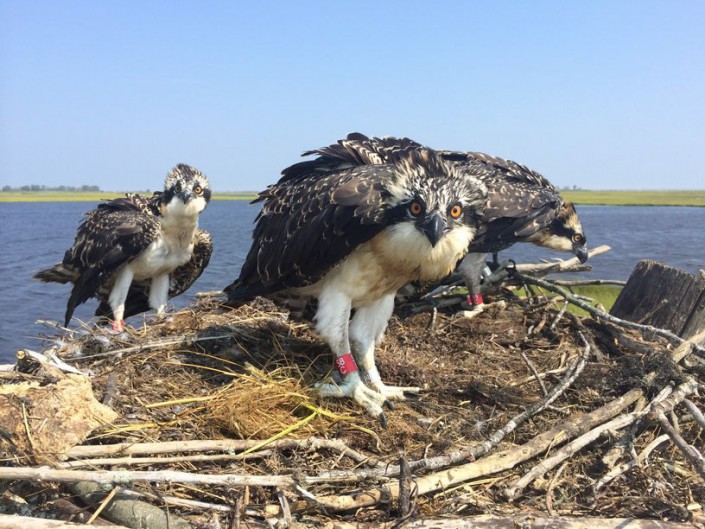New Jersey Ospreys Banded for Scientific Study at All Time High
Conserve Wildlife Foundation of New Jersey Releases Results of 2014 Osprey Report
By: Lindsay McNamara, Communications Coordinator

Conserve Wildlife Foundation of New Jersey (CWF) today released the 2014 Osprey Project Report, highlighting the number of nesting pairs, active nests and nest productivity for the raptors throughout New Jersey with data collected by New Jersey Department of Environmental Protection Division of Fish and Wildlife biologists, CWFNJ biologists and dedicated volunteers. A new all-time high number of young osprey were banded for future tracking.
“The comeback of these magnificent birds continues to inspire us, especially in combination with the parallel recoveries of bald eagles and peregrine falcons,” said David Wheeler, CWF Executive Director. “Ospreys depend on a strong fish population and healthy waters, so they are a strong indicator of our recovering coastal and inland waters in New Jersey.”
To keep track of the health of New Jersey’s osprey population, biologists and volunteers conduct surveys each year. These surveys focus on the most densely populated colonies of nesting ospreys in New Jersey. From the Meadowlands to Cape May and along Delaware Bay, a sample of each area is recorded. The data is used to determine the health of the population. While surveys are conducted, osprey nestlings are also banded with United States Geological Survey (USGS) bird bands for future tracking.
2014 Report Highlights:
- In 2014, 420 active osprey nests were recorded. A total of 25 new nests were recorded this year.
- With this data and last year’s census, the overall 2014 population is estimated at 567 pairs, up from 542 pairs in 2013.
- 339 known-outcome nests fledged an average of 2.02 young per active nest, which is a slight increase from 1.92 in 2013.
- A total of 526 young, a new all-time high, were banded by volunteers and staff with USGS leg bands for future tracking.
This season, weather conditions and prey availability were favorable for ospreys. Temperatures and precipitation were both average this summer. A common item in New Jersey osprey diet continues to be Atlantic Menhaden. The productivity of the ospreys is dependent on the health and abundance of coastal fisheries.
To help engage citizen scientists for the first time in over 20 years, young ospreys have been marked with an auxiliary color band in New Jersey. The new band, which is a red anodized aluminum rivet band, bears an alpha-numeric code. This coded band allows birders, osprey watchers and wildlife photographers the ability to identify individual birds. This new project, “Project RedBand” is focused on ospreys that nest in the Barnegat Bay watershed from Point Pleasant to Little Egg Harbor.
“The use of the auxiliary ‘red bands’ will help us learn a lot about the ecology of ospreys nesting on Barnegat Bay,” stated CWF Habitat Program Manager Ben Wurst. “Project RedBand will also help us engage local communities in osprey conservation and management by encouraging citizens to report re-sightings of banded birds. We are hopeful that this project will instill in New Jersey residents a long lasting appreciation for birds of prey and the habitat they require to survive.”
Learn More:
- Read the full 2014 Osprey Project Report
- Newsworks Down the Shore Blog: Osprey population hits all time high in New Jersey, study finds
- Check out Project RedBand news and sightings!
- Check out Conserve Wildlife Foundation’s online field guide for more information about the osprey
Lindsay McNamara is the Communications Coordinator for Conserve Wildlife Foundation of New Jersey.